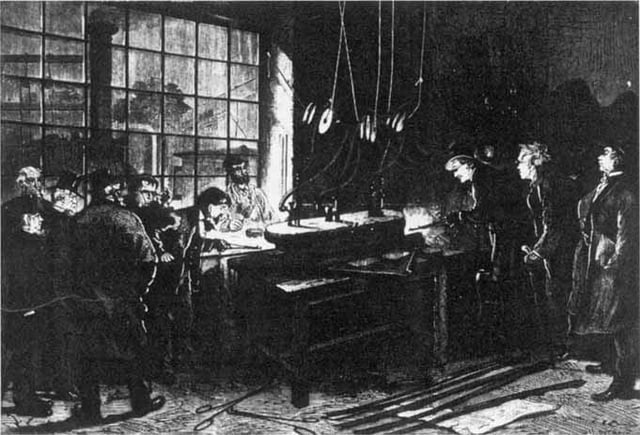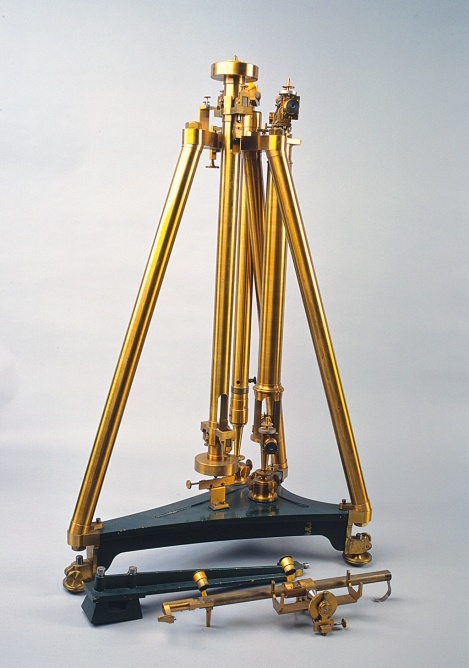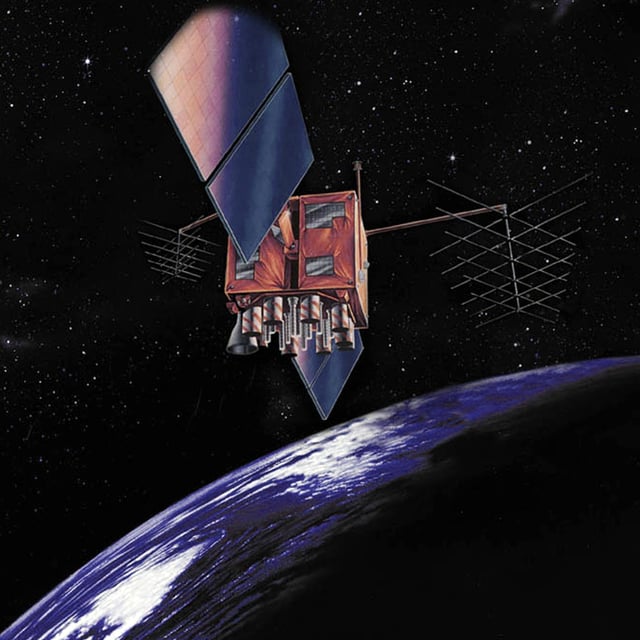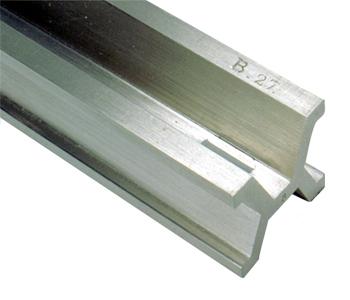Metre

Metre
The metre (Commonwealth spelling and BIPM spelling[1]) or meter (American spelling[2]) (from the French unit mètre, from the Greek noun μέτρον, "measure") is the base unit of length in the International System of Units (SI). The SI unit symbol is m.[3] The metre is defined as the length of the path travelled by light in a vacuum in 1/299 792 458 of a second.[1]
The metre was originally defined in 1793 as one ten-millionth of the distance from the equator to the North Pole – as a result, the Earth's circumference is approximately 40,000 km today. In 1799, it was redefined in terms of a prototype metre bar (the actual bar used was changed in 1889). In 1960, the metre was redefined in terms of a certain number of wavelengths of a certain emission line of krypton-86. In 1983, the current definition was adopted.
The imperial inch is defined as 0.0254 metres (2.54 centimetres or 25.4 millimetres). One metre is about 3 3⁄8 inches longer than a yard, i.e. about 39 3⁄8 inches.
Spelling
Etymology
The etymological roots of metre can be traced to the Greek verb μετρέω (metreo) (to measure, count or compare) and noun μέτρον (metron) (a measure), which were used for physical measurement, for poetic metre and by extension for moderation or avoiding extremism (as in "be measured in your response"). This range of uses is also found in Latin (metior, mensura), French (mètre, mesure), English and other languages. The motto ΜΕΤΡΩ ΧΡΩ (metro chro) in the seal of the International Bureau of Weights and Measures (BIPM), which was a saying of the Greek statesman and philosopher Pittacus of Mytilene and may be translated as "Use measure!", thus calls for both measurement and moderation. The use of the word metre (for the French unit mètre) in English began at least as early as 1797.[12]
History of definition

Meridian room of the Paris Observatory (or Cassini room): the Paris meridian is drawn on the ground.
In 1671 Jean Picard measured the length of a "seconds pendulum" (a pendulum with a period of two seconds) at the Paris observatory. He found the value of 440.5 lines of the Toise of Châtelet which had been recently renewed. He proposed a universal toise (French: Toise universelle) which was twice the length of the seconds pendulum.[13][14] However, it was soon discovered that the length of a seconds pendulum varies from place to place: French astronomer Jean Richer had measured the 0.3% difference in length between Cayenne (in French Guiana) and Paris.[15][13][17]
Jean Richer and Giovanni Domenico Cassini measured the parallax of Mars between Paris and Cayenne in French Guiana when Mars was at its closest to Earth in 1672. They arrived at a figure for the solar parallax of 91/2 inches, equivalent to an Earth–Sun distance of about 22000 Earth radii. They were also the first astronomers to have access to an accurate and reliable value for the radius of Earth, which had been measured by their colleague Jean Picard in 1669 as 3269 thousand toises. Picard's geodetic observations had been confined to the determination of the magnitude of the Earth considered as a sphere, but the discovery made by Jean Richer turned the attention of mathematicians to its deviation from a spherical form. In addition to its significance for cartography, the determination of the Figure of the Earth became a problem of the highest importance in astronomy, inasmuch as the diameter of the Earth was the unit to which all celestial distances had to be referred.[18][19][20][21]
Meridional definition

Paris Panthéon

The beginning of the U. S. coastal survey.
As a result of the French Revolution, the French Academy of Sciences charged a commission with determining a single scale for all measures. On 7 October 1790 that commission advised the adoption of a decimal system, and on 19 March 1791 advised the adoption of the term mètre ("measure"), a basic unit of length, which they defined as equal to one ten-millionth of the distance between the North Pole and the Equator.[22][23][24][25] In 1793, the French National Convention adopted the proposal.[12]
The French Academy of Sciences commissioned an expedition led by Jean Baptiste Joseph Delambre and Pierre Méchain, lasting from 1792 to 1799, which attempted to accurately measure the distance between a belfry in Dunkerque and Montjuïc castle in Barcelona at the longitude of Paris Panthéon.[26] The expedition was fictionalised in Denis Guedj, Le Mètre du Monde.[27] Ken Alder wrote factually about the expedition in The Measure of All Things: the seven year odyssey and hidden error that transformed the world.[27] This portion of the Paris meridian, was to serve as the basis for the length of the half meridian connecting the North Pole with the Equator. From 1801 to 1812 France adopted this definition of the metre as its official unit of length based on results from this expedition combined with those of the Geodesic Mission to Peru.[29][30] The latter was related by Larrie D. Ferreiro in Measure of the Earth: The Enlightenment Expedition that Reshaped Our World.[31]
A more accurate determination of the Figure of the Earth would soon result from the measurement of the Struve Geodetic Arc (1816-1855) and would have given another value for the definition of this standard of length. This did not invalidate the metre but highlighted that progresses in science would allow better measurement of Earth's size and shape.[20] After the July Revolution of 1830 the metre became the definitive French standard from 1840. At that time it had already been adopted by Ferdinand Rudolph Hassler for the U.S Survey of the Coast.[29][32][33]
"The unit of length to which all distances measured in the Coast Survey are referred is the French metre, an authentic copy of which is preserved in the archives of the Coast Survey Office.
It is the property of the American Philosophical Society, to whom it was presented by Mr. Hassler, who had received it from Tralles, a member of the French Committee charged with the construction of the standard metre by comparison with the toise, which had served as unit of length in the measurement of the meridional arcs in France and Peru.
It possesses all the authenticity of any original metre extant, bearing not only the stamp of the Committee but also the original mark by which it was distiguished from the other bars during the operation of standarding.
It is always designated as the Committee metre" (French : Mètre des Archives). Clarke, Alexander Ross (1873), "XIII. Results of the comparisons of the standards of length of England, Austria, Spain, United States, Cape of Good Hope, and of a second Russian standard, made at the Ordnance Survey Office, Southampton. With a preface and notes on the Greek and Egyptian measures of length by Sir Henry James" [92], Philosophical Transactions, London, 163, p. 463, doi:10.1098/rstl.1873.0014 [93]
In 1830 President Andrew Jackson mandated Ferdinand Rudolf Hassler to work out new standards for all U.S. states. According to the decision of the Congress of the United States, the British Parlementary Standard from 1758 was introduced as the unit of length.[34] Another geodesist with metrology skills was to play a pivotal role in the process of internationalization of weights and measures, Carlos Ibáñez e Ibáñez de Ibero who would become the first president of both the International Geodetic Association and the International Committee for Weights and Measures.[35]
International prototype metre bar

Creating the metre-alloy in 1874 at the Conservatoire des Arts et Métiers.

Gravimeter with variant of Repsold pendulum

Artist's impression of a GPS-IIR satellite in orbit.
In 1867 at the second general conference of the International Association of Geodesy held in Berlin, the question of an international standard unit of length was discussed in order to combine the measurements made in different countries to determine the size and shape of the Earth.[36][37][38] The conference recommended the adoption of the metre in replacement of the toise and the creation of an international metre commission, according to the proposal of Johann Jacob Baeyer, Adolphe Hirsch and Carlos Ibáñez e Ibáñez de Ibero who had devised two geodetic standards calibrated on the metre for the map of Spain.[36][38][33][39] Measurement traceability between the toise and the metre was ensured by comparison of the Spanish standard with the standard devised by Borda and Lavoisier for the survey of the meridian arc connecting Dunkirk with Barcelona.[39][40][35]
A member of the Preparatory Committee since 1870 and Spanish representative at the Paris Conference in 1875, Carlos Ibáñez e Ibáñez de Ibero intervened with the French Academy of Sciences to rally France to the project to create an International Bureau of Weights and Measures equipped with the scientific means necessary to redefine the units of the metric system according to the progress of sciences.[41]
In the 1870s and in light of modern precision, a series of international conferences was held to devise new metric standards.
The Metre Convention (Convention du Mètre) of 1875 mandated the establishment of a permanent International Bureau of Weights and Measures (BIPM: Bureau International des Poids et Mesures) to be located in Sèvres, France. This new organisation was to construct and preserve a prototype metre bar, distribute national metric prototypes, and maintain comparisons between them and non-metric measurement standards. The organisation distributed such bars in 1889 at the first General Conference on Weights and Measures (CGPM: Conférence Générale des Poids et Mesures), establishing the International Prototype Metre as the distance between two lines on a standard bar composed of an alloy of 90% platinum and 10% iridium, measured at the melting point of ice.[42]
The comparison of the new prototypes of the metre with each other and with the Committee metre (French: Mètre des Archives) involved the development of special measuring equipment and the definition of a reproducible temperature scale. The BIPM's thermometry work led to the discovery of special alloys of iron-nickel, in particular invar, for which its director, the Swiss physicist Charles-Edouard Guillaume, was granted the Nobel Prize for physics in 1920.[43]
As Carlos Ibáñez e Ibáñez de Ibero stated, the progress of metrology combined with those of gravimetry through improvement of Kater's pendulum led to a new era of geodesy. If precision metrology had needed the help of geodesy, the latter could not continue to prosper without the help of metrology. Indeed how to express all the measurements of terrestrial arcs as a function of a single unit, and all the determinations of the force of gravity with the pendulum, if metrology had not created a common unit, adopted and respected by all civilized nations, and if in addition one had not compared, with great precision, to the same unit all the standards for measuring geodesic bases, and all the pendulum rods that had hitherto been used or would be used in the future? Only when this series of metrological comparisons would be finished with a probable error of a thousandth of a millimeter would geodesy be able to link the works of the different nations with one another, and then proclaim the result of the last measurement of the Globe. As the figure of the Earth could be inferred from variations of the seconds pendulum length with latitude, the United States Coast Survey instructed Charles Sanders Peirce in the spring of 1875 to proceed to Europe for the purpose of making pendulum experiments to chief initial stations for operations of this sort, in order to bring the determinations of the forces of gravity in America into communication with those of other parts of the world; and also for the purpose of making a careful study of the methods of pursuing these researches in the different countries of Europe. In 1886 the association of geodesy changed name for the International Geodetic Association, which Carlos Ibáñez e Ibáñez de Ibero presided up to his death in 1891. During this period the International Geodetic Association (German: Internationale Erdmessung) gained worldwide importance with the joining of United States, Mexico, Chile, Argentina and Japan.[44][45][46][47][35][35]
Efforts to supplement the various national surveying systems, which begun in the 19th century with the foundation of the Mitteleuropäische Gradmessung, resulted in a series of global ellipsoids of the Earth (e.g., Helmert 1906, Hayford 1910/1924) which would later lead to develop the World Geodetic System. Nowadays the practical realisation of the metre is possible everywhere thanks to the atomic clocks embedded in GPS satellites.[50][51]
Wavelength definition
In 1893, the standard metre was first measured with an interferometer by Albert A. Michelson, the inventor of the device and an advocate of using some particular wavelength of light as a standard of length. By 1925, interferometry was in regular use at the BIPM. However, the International Prototype Metre remained the standard until 1960, when the eleventh CGPM defined the metre in the new International System of Units (SI) as equal to 1 650 763.73 wavelengths of the orange-red emission line in the electromagnetic spectrum of the krypton-86 atom in a vacuum.[52]
Speed of light definition
To further reduce uncertainty, the 17th CGPM in 1983 replaced the definition of the metre with its current definition, thus fixing the length of the metre in terms of the second and the speed of light:[1]
This definition fixed the speed of light in vacuum at exactly 299792458 metres per second (≈300000 km/s). An intended by-product of the 17th CGPM's definition was that it enabled scientists to compare lasers accurately using frequency, resulting in wavelengths with one-fifth the uncertainty involved in the direct comparison of wavelengths, because interferometer errors were eliminated. To further facilitate reproducibility from lab to lab, the 17th CGPM also made the iodine-stabilised helium–neon laser "a recommended radiation" for realising the metre.[53] For the purpose of delineating the metre, the BIPM currently considers the HeNe laser wavelength, λHeNe, to be 632.99121258 nm with an estimated relative standard uncertainty (U) of 2.1×10−11.[53][54][27] This uncertainty is currently one limiting factor in laboratory realisations of the metre, and it is several orders of magnitude poorer than that of the second, based upon the caesium fountain atomic clock (U = 5×10−16).[27] Consequently, a realisation of the metre is usually delineated (not defined) today in labs as 1579800.762042(33) wavelengths of helium-neon laser light in a vacuum, the error stated being only that of frequency determination.[53] This bracket notation expressing the error is explained in the article on measurement uncertainty.
Practical realisation of the metre is subject to uncertainties in characterising the medium, to various uncertainties of interferometry, and to uncertainties in measuring the frequency of the source.[57] A commonly used medium is air, and the National Institute of Standards and Technology (NIST) has set up an online calculator to convert wavelengths in vacuum to wavelengths in air.[58] As described by NIST, in air, the uncertainties in characterising the medium are dominated by errors in measuring temperature and pressure. Errors in the theoretical formulas used are secondary.[59] By implementing a refractive index correction such as this, an approximate realisation of the metre can be implemented in air, for example, using the formulation of the metre as 1579800.762042(33) wavelengths of helium–neon laser light in vacuum, and converting the wavelengths in a vacuum to wavelengths in air. Air is only one possible medium to use in a realisation of the metre, and any partial vacuum can be used, or some inert atmosphere like helium gas, provided the appropriate corrections for refractive index are implemented.[60]
The metre is defined as the path length travelled by light in a given time and practical laboratory length measurements in metres are determined by counting the number of wavelengths of laser light of one of the standard types that fit into the length,[63] and converting the selected unit of wavelength to metres. Three major factors limit the accuracy attainable with laser interferometers for a length measurement:[57][27]
uncertainty in vacuum wavelength of the source,
uncertainty in the refractive index of the medium,
least count resolution of the interferometer.
Of these, the last is peculiar to the interferometer itself.
The conversion of a length in wavelengths to a length in metres is based upon the relation
which converts the unit of wavelength λ to metres using c, the speed of light in vacuum in m/s. Here n is the refractive index of the medium in which the measurement is made, and f is the measured frequency of the source. Although conversion from wavelengths to metres introduces an additional error in the overall length due to measurement error in determining the refractive index and the frequency, the measurement of frequency is one of the most accurate measurements available.[27]
Timeline

Closeup of National Prototype Metre Bar No.
8 May 1790 – The French National Assembly decides that the length of the new metre would be equal to the length of a pendulum with a half-period of one second.[29]
30 March 1791 – The French National Assembly accepts the proposal by the French Academy of Sciences that the new definition for the metre be equal to one ten-millionth of the length of a quadrant along the Earth's meridian through Paris, that is the distance from the equator to the north pole along that quadrant.[14]
1795 – Provisional metre bar made of brass and based on Paris meridan arc (French: Méridienne de France) measured by Nicolas-Louis de Lacaillle and Cesar-François Cassini de Thury, legally equal to 443.44 lines of the toise du Pérou (a standard French unit of length from 1766).[29][30][40][51]
10 December 1799 – The French National Assembly specifies the platinum metre bar, presented on 22 June 1799 and deposited in the National Archives, as the final standard. Legally equal to 443.296 lines on the toise du Pérou.[51]
24-28 September 1889 – The 1st General Conference on Weights and Measures (CGPM) defines the metre as the distance between two lines on a standard bar of an alloy of platinum with 10% iridium, measured at the melting point of ice.[51][66]
27 september - 6 October 1927 – The 7th CGPM redefines the metre as the distance, at 0 °C (273 K), between the axes of the two central lines marked on the prototype bar of platinum-iridium, this bar being subject to one standard atmosphere of pressure and supported on two cylinders of at least 10 mm (1 cm) diameter, symmetrically placed in the same horizontal plane at a distance of 571 mm (57.1 cm) from each other.[67]
14 October 1960 – The 11th CGPM defines the metre as 1650763.73 wavelengths in a vacuum of the radiation corresponding to the transition between the 2p10 and 5d5 quantum levels of the krypton-86 atom.[42]
21 October 1983 – The 17th CGPM defines the metre as the length of the path travelled by light in a vacuum during a time interval of 1/299 792 458 of a second.[42]
2002 – The International Committee for Weights and Measures (CIPM) considers the metre to be a unit of proper length and thus recommends this definition be restricted to "lengths ℓ which are sufficiently short for the effects predicted by general relativity to be negligible with respect to the uncertainties of realisation".[42]
| Basis of definition | Date | Absoluteuncertainty | Relativeuncertainty |
|---|---|---|---|
| 1/10 000 000part of thequadrantalong themeridian, measurement byDelambreandMéchain(443.296 lines) | 1795 | 500–100μm | 10−4 |
First prototype *Mètre des Archives
| 1799 | 50–10μm | 10−5 |
| Platinum-iridium bar at melting point of ice (1stCGPM) | 1889 | 0.2–0.1 μm (200–100 nm) | 10−7 |
| Platinum-iridium bar at melting point of ice, atmospheric pressure, supported by two rollers (7th CGPM) | 1927 | n.a. | n.a. |
| Hyperfineatomic transition;1650763.73wavelengths of light from a specified transition inkrypton-86(11th CGPM) | 1960 | 4nm | 4×10−9[1] |
| Length of the path travelled by light in a vacuum in1/299 792 458second (17th CGPM) | 1983 | 0.1nm | 10−10 |
SI prefixed forms of metre
SI prefixes are often employed to denote decimal multiples and submultiples of the metre, as shown in the table below. As indicated in the table, some are commonly used, while others are not. Long distances are usually expressed in km, astronomical units (149.6 Gm), light-years (10 Pm), or parsecs (31 Pm), rather than in Mm, Gm, Tm, Pm, Em, Zm or Ym; "30 cm", "30 m", and "300 m" are more common than "3 dm", "3 dam", and "3 hm", respectively.
The terms micron and (occasionally) millimicron are often used instead of micrometre (μm) and nanometre (nm), but this practice is officially discouraged.[42]
Equivalents in other units
| Metric unitexpressed in non-SI units | Non-SI unitexpressed in metric units | |||||||
|---|---|---|---|---|---|---|---|---|
| 1 metre | ≈ | 1.0936 | yard | 1 yard | ≡ | 0.9144 | metre | |
| 1 metre | ≈ | 39.370 | inches | 1 inch | ≡ | 0.0254 | metre | |
| 1centimetre | ≈ | 0.39370 | inch | 1 inch | ≡ | 2.54 | centimetres | |
| 1millimetre | ≈ | 0.039370 | inch | 1 inch | ≡ | 25.4 | millimetres | |
| 1 metre | ≡ | 1 × 1010 | ångström | 1 ångström | ≡ | 1 × 10−10 | metre | |
| 1nanometre | ≡ | 10 | ångström | 1 ångström | ≡ | 100 | picometres | |
Within this table, "inch" and "yard" mean "international inch" and "international yard"[27] respectively, though approximate conversions in the left column hold for both international and survey units.
- "≈" means "is approximately equal to";"≡" means "equal by definition" or "is exactly equal to".
One metre is exactly equivalent to 5 000/127 inches and to 1 250/1 143 yards.
A simple mnemonic aid exists to assist with conversion, as three "3"s:
- 1 metre is nearly equivalent to 3inches.This gives an overestimate of 0.125mm; however, the practice of memorising such conversion formulas has been discouraged in favour of practice and visualisation of metric units.
The ancient Egyptian cubit was about 0.5 m (surviving rods are 523–529 mm). Scottish and English definitions of the ell (two cubits) were 941 mm (0.941 m) and 1143 mm (1.143 m) respectively. The ancient Parisian toise (fathom) was slightly shorter than 2 m and was standardised at exactly 2 m in the mesures usuelles system, such that 1 m was exactly 1⁄2 toise. The Russian verst was 1.0668 km. The Swedish mil was 10.688 km, but was changed to 10 km when Sweden converted to metric units.
See also
Conversion of units for comparisons with other units
Introduction to the metric system
ISO 1 – standard reference temperature for length measurements
Length measurement
Metre Convention
Metric system
Orders of magnitude (length)
SI prefix
Vertical metre